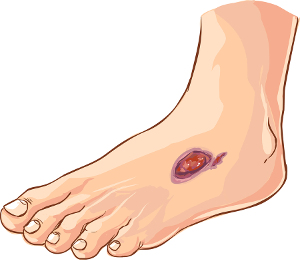When someone in your life suffers from diabetes, there is no such thing as a small or superficial wound. When a person normally stubs their toe, steps on a tack or cuts themselves shaving, they hardly give any thought to the resulting scrape or cut. However, when the same thing happens to someone with diabetes, it is vitally important to ensure that the resulting wound is treated properly. Treating minor wounds immediately is the only way to ensure the wound heals properly and does not become infected. Foot ulcers, slow-healing wounds, and advanced infections may require more advanced treatments which may include being seen by a physician.
Complications Caused by Diabetes
 A non-diabetic person will have no problem dealing with a minor cut or scrape on the leg, foot, neck or face, but someone who has diabetes may experience complications that could cause them to be completely unaware of the wound until it becomes infected.
A non-diabetic person will have no problem dealing with a minor cut or scrape on the leg, foot, neck or face, but someone who has diabetes may experience complications that could cause them to be completely unaware of the wound until it becomes infected.
Diabetes-related complications may include neuropathy or nerve damage, compromised immune system, and narrow or clogged arteries. These complications can make it impossible for someone with diabetes to feel a wound, like a cut or a blister, on their foot until it has become very advanced and infected. This could lead to advanced infection and foot ulcers which could lead to amputation of the affected foot.
Treating Diabetic Wounds Properly
When a diabetic person is injured, there are several important steps that must be taken to ensure that their wound is treated properly.
- Clean the wound thoroughly. No matter how minor it seems, the wound must be rinsed continually under running water until all signs of dirt are rinsed away. Do not use soap to clean the wound or hydrogen peroxide, alcohol or iodine. Any of these may irritate the skin, doing more damage than good.
- Apply an antibiotic ointment and cover the wound. Cover the wound with a fresh, sterile bandage. Keeping the wound protected will help promote healing and prevent infection.
- Change the dressing every day. Changing the dressing will not only keep the wound clean, it will also give you a chance to inspect the wound every day for signs of infection. At this point, it is a good idea to clean the wound with soap and water each time you change the bandage.
- Take it easy. Give your wound a chance to heal before putting a lot of pressure on it.
- See the doctor. While you usually would not see the doctor for a minor injury, in the case of a diabetic patient, the doctor will likely make an exception. If you have diabetes, always be exceptionally careful when you have a wound on an extremity.
What Happens When a Diabetes Wound Does Not Heal Properly?
In some cases, despite being properly handled, a diabetic wound simply will not heal. In cases like this your doctor may advise you to receive more advanced treatments. These treatments may include more advanced dressings, surgical debridement or removal of dead tissue, off-loading or ‘wound pressure relief,’ graft therapy and hyperbaric oxygen therapy. All of these advanced treatments may require that you see a specialist and receive treatment at a special treatment facility.
For more information about diabetic wound treatments, get in touch with DFW Wound Care Center right away by calling us at call us at 972-665-6292 in Plano, 972-318-2383 in Lewisville or 972-607-9643 in Irving.
Contact us
Schedule an appointment
with our specialists by contacting us or calling our:
